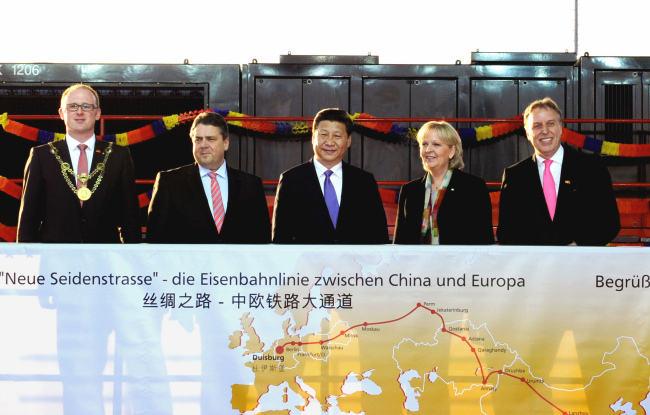FRANKFURT (AFP) ― One of the world’s longest railways ― a “modern-day silk road” ― covers some 11,000 kilometers en route from the Chinesee megacity of Chongqing to Duisburg, a key commercial hub in western Germany.
On Saturday, as part of his landmark visit to Germany, Chinese President Xi Jinping visited the last stop on the “Yuxinou” rail line, an industrial feat that promises to revolutionize transport between Europe and Asia.
Duisburg is a steel-making town of around half a million on the confluence of the Rhine and Ruhr rivers that boasts the world’s biggest inland port and is one of Germany’s most important transport and commercial hubs.
Despite the vast distances between them, it takes just 16 days for trains to travel to Duisburg from Chongqing, a sprawling metropolitan symbol of rising China with a population of more than 30 million.
On Saturday, as part of his landmark visit to Germany, Chinese President Xi Jinping visited the last stop on the “Yuxinou” rail line, an industrial feat that promises to revolutionize transport between Europe and Asia.
Duisburg is a steel-making town of around half a million on the confluence of the Rhine and Ruhr rivers that boasts the world’s biggest inland port and is one of Germany’s most important transport and commercial hubs.
Despite the vast distances between them, it takes just 16 days for trains to travel to Duisburg from Chongqing, a sprawling metropolitan symbol of rising China with a population of more than 30 million.

Xi, accompanied by a large delegation and German Economy Minister Sigmar Gabriel, ceremoniously welcomed a freight train crammed with laptops and electronics after it completed its journey through Central Asia, Russia, Belarus and Poland.
Set up in 2011 by a group of rail companies, the Yuxinou is just 2,000 km short of the world’s longest rail line that links Germany to Shanghai. It has shaved more than 20 days off the sea route.
The route is particularly useful for Chongqing ― home to vast car parts and IT factories ― since it lies 1,500 km from China’s main seaports.
“The value of this rail link, known in China as the ‘new silk road’, is more than just symbolic,” the spokesman of the port of Duisburg, Julian Boecker, told AFP.
“It has found itself a position in the market and now operates up to three weekly services,” he said.
But one of the biggest challenges will be to boost traffic in both directions to make it more profitable.
It is not uncommon for the Yuxinou trains, which can transport as many as 50 containers, to be full when they arrive in Duisburg but empty when they return to China.
“At the moment, the amount of goods travelling from China to Europe is much larger than the other way round. That’s a problem,” said Maria Leenen, director of market research group SCI Verkehr.
It was sea transport that gradually supplanted the historic Silk Road trade route linking Asia with Europe centuries ago.
Sea transport still accounts for more than 95 percent of goods trading between the two regions, said Burkhard Lemper of the logistics consultants ISL.
Rail’s share of the market remains tiny, and for now, the Yuxinou link only complements existing transport systems.
But “rail is twice as fast as sea transport and twice as cheap as air freight,” said Erich Staake, head of the company that operates the Duisburg port.
For Leenen, “both sides benefit” from the link.
“Europe can meet a sudden surge in demand in industry or trade, say in textiles, while China can reach its markets more rapidly,” she said.
The link provides a welcome transport connection and gateway for Chinese provinces situated deep inside the country.
“It’s still early days yet for this mode of transport. But it could have a promising future if the conditions are right, notably in terms of safety and security, punctuality and a stable political situation,” Leenen said.
Other electronics companies, such as Foxconn of Taiwan which supplies Apple, or computer giant Acer, as well as car parts suppliers and machine-tool makers, all have factories in Chongqing.
The port of Duisburg hopes that the importance of the rail link will increase after Xi’s visit.
“We’re in negotiations with companies, such as automakers, on a possible expansion of the service,” Boecker said.
“There are people who aren’t aware that it even exists,” he said. “We hope to increase customers in both directions.”
China is Germany’s top trade partner in Asia, while Germany is China’s leading European partner. Bilateral trade exceeded $161.5 billion last year.
-
Articles by Korea Herald



![[Herald Interview] 'Amid aging population, Korea to invite more young professionals from overseas'](http://res.heraldm.com/phpwas/restmb_idxmake.php?idx=644&simg=/content/image/2024/04/24/20240424050844_0.jpg&u=20240424200058)













![[KH Explains] Korean shipbuilding stocks rally: Real growth or bubble?](http://res.heraldm.com/phpwas/restmb_idxmake.php?idx=652&simg=/content/image/2024/04/25/20240425050656_0.jpg&u=)

